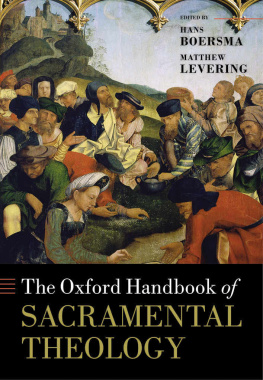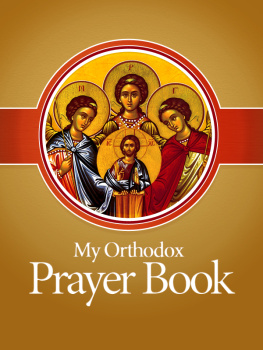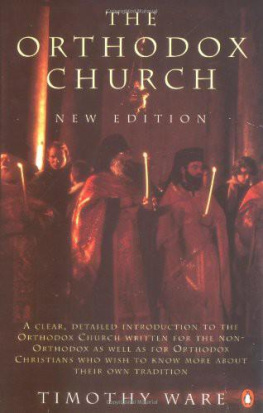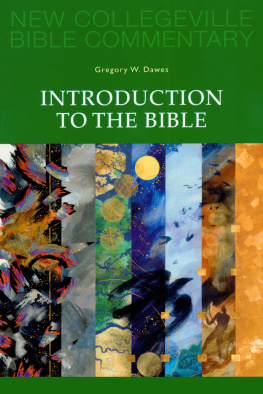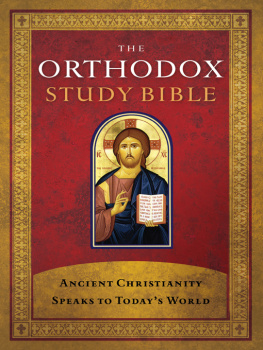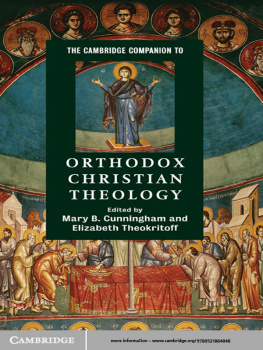The Oxford Handbook of
the Bible in Orthodox Christianity

Oxford University Press is a department of the University of Oxford. It furthers the Universitys objective of excellence in research, scholarship, and education by publishing worldwide. Oxford is a registered trade mark of Oxford University Press in the UK and certain other countries.
Published in the United States of America by Oxford University Press
198 Madison Avenue, New York, NY 10016, United States of America.
Oxford University Press 2022
All rights reserved. No part of this publication may be reproduced, stored in a retrieval system, or transmitted, in any form or by any means, without the prior permission in writing of Oxford University Press, or as expressly permitted by law, by license, or under terms agreed with the appropriate reproduction rights organization. Inquiries concerning reproduction outside the scope of the above should be sent to the Rights Department, Oxford University Press, at the address above.
You must not circulate this work in any other form and you must impose this same condition on any acquirer.
Library of Congress Cataloging-in-Publication Data
Names: Pentiuc, Eugen J., 1955- editor.
Title: The Oxford handbook of the Bible in Orthodox Christianity /
[edited by Eugen J. Pentiuc].
Description: New York, NY : Oxford University Press, [2022] |
Includes bibliographical references and index.
Identifiers: LCCN 2021057622 (print) | LCCN 2021057623 (ebook) |
ISBN 9780190948658 (hardback) | ISBN 9780190948672 (epub)
Subjects: LCSH: BibleCriticism, interpretation, etc. |
Orthodox Eastern ChurchDoctrines.
Classification: LCC BS511.3 .O95 2022 (print) | LCC BS511.3 (ebook) |
DDC 220.6dc23/eng/20220210
LC record available at https://lccn.loc.gov/2021057622
LC ebook record available at https://lccn.loc.gov/2021057623
DOI: 10.1093/oxfordhb/9780190948658.001.0001
Contents
Eugen J. Pentiuc
Miltiadis Konstantinou
Alexandru Mihil
Daniel Olariu
George A. Kiraz
Hany N. Takla
Garegin Hambardzumyan
Gregory S. Paulson
Simon Crisp
Lee Martin McDonald
Edith M. Humphrey
Ioan Chiril
Petros Vassiliadis
Daniel Assefa
Silviu N. Bunta
Stefanos Alexopoulos
Alexis Torrance
Athanasios Despotis
Konstantin Nikolakopoulos
Theodore G. Stylianopoulos
John Fotopoulos
Christopher R. Seitz
Bradley Nassif
Anthony G. Roeber
Sebastian P. Brock
Mersha Alehegne
Vahan Hovhanessian
Mary K. Farag
Harry Pappas
Bruce N. Beck
Bogdan G. Bucur
Nicolae Roddy
John Behr
Brent A. Strawn
Michael G. Azar
David A. Wilkinson
Nikolaos Chatzinikolaou
Ashley M. Purpura
Olivier-Thomas Venard
Justin A. Mihoc
James Buchanan Wallace
R. W. L. (Walter) Moberly
At first glance, the Orthodox Church might not appear to place as much emphasis on the Bible relative to other Christian denominations, but, to the contrary, everything in the spirituality of the Eastern Church springs from Holy Scripture. The Church Fathers possessed an organic relationship with the sacred texts. They were very quickly translated into other languages as a means for Christian expansion and mission throughout the Roman Empire and beyond. The Bible is the wellspring of the liturgy. It is inseparable from the sacraments. It is the source of iconography. The Bible is the life of the Church at the intersection of communion and salvation.
Therefore, I am delighted to commend Fr. Eugen J. Pentiucs present work: Oxford Handbook of the Bible in Orthodox Christianity. As editor of the present volume, he has almost four decades of pastoral experience in Romania, Israel, and the United States, and is a prolific theologian and biblical scholar. He is in a unique position to take on this significant project with the collaboration of many Orthodox and non-Orthodox biblical scholars, in order to celebrate the fascinating development of the Bible in Eastern and Oriental Orthodox Christianity.
Regarding the text of Scripture, Orthodoxy has never canonized a specific textual tradition (e.g., Old GreekSeptuagint over HebrewMasoretic Text). While always breathing through the Septuagint, the Orthodox Church has not closed the door on other textual traditions, Origens Hexapla being a monumental example of textual fluidity. Moreover, the Slavic, Arabic, and Romanian translations, as well as Oriental Orthodox translations (Syriac, Coptic, Ethiopian, Armenian), speak volumes about Orthodox Christianitys flexibility with respect to the biblical text and its transmission.
A brief survey of the canonical lists in Eastern and Oriental Orthodox traditions shows a wide variety of views. If the New Testament canon remains relatively well configured at twenty-seven books, the Old Testament canon is quite elastic in its remote boundaries. While all thirty-nine canonical books of the Hebrew Bible are to be found in any Bible of Byzantine and Oriental churches, the number of the (readable, St. Athanasiuss coinage) differs from one community to another: forty-nine Old Testament books in Byzantine Orthodoxy, and the broadest canon in the Ethiopian tradition. Another conundrum is the status of these : Are they considered canonical as are the thirty-nine or noncanonical ( , St. Athanasius)? Put differently, is it the ongoing liturgical use of these that makes them canonical?
All Orthodox traditions insist on the centrality of Scripture within tradition. While Scripture as Gods word vested in human words remains central, tradition, as the matrix and living context of the Church, is in a continuous symbiosis with Scripture. Note that tradition from an Orthodox perspective is more than a mere deposit of faith; it is the Churchs life under the guidance of the Holy Spirit approaching the eschaton.
Perhaps the main characteristic of Orthodox Christianity in terms of biblical hermeneutics is that there is no Orthodox hermeneutics in the sense of a well-configured, restrictive, or closed system. Contributors in this section show the diversity of Orthodox hermeneutics diachronically from ancient to modern times and synchronically across the wide spectrum of Orthodoxy from Eastern (Byzantine) to Oriental traditions.
Looking to the future, the biggest challenge for Orthodox in postmodern times is how to bridge time-honored patristic hermeneutics with the modern historical-critical method and postmodern literary approaches. Contributions in this section by Orthodox and non-Orthodox biblical scholars are at the cutting edge of current biblical hermeneutical conversations. Are the diachronic (i.e., modern historical-criticism) modes of interpretation ready or even able to converse with the synchronic (i.e., ancient patristic and postmodern canonical and literary approaches) modes of interpretation? Will they enter into an ever-changing and reciprocal complementarity? It remains to be seen in the future.
In closing, allow me to repeat that I see this handbook as a sign of and witness to Orthodox unity. Studying and teaching the Word of God as recorded in and conveyed to us throughout the centuries of the Churchs living tradition can be a great catalyst toward a complete unity in diversity of all the various branches of Orthodox Christianity. Important seeds are sown in this handbook; the harvest is yet to come.




